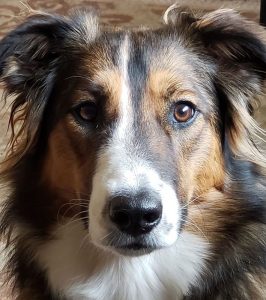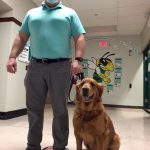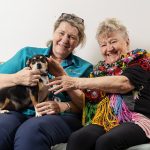Help Your Dog
July 2, 2020

Costumes or facial coverings—even just hats—change our general appearance to the dog and we may be perceived as a threat initially. Or the dog may simply perceive [the facial covering] as an impediment to their ability to read our facial expressions and body language. I would suggest trying to desensitize the dog by putting the mask up to your face for very brief periods of time and, at the same time, rewarding your dog with something that he likes—treats or petting if your dog likes that. You will be combining desensitization with positive reinforcement. The goal is always that the dog associates good things with the appearance of the mask whether it’s on your face or not. Next, you can start to increase the time of mask wearing while spreading out the rewards or randomizing them. All of this should be done in a setting where your dog feels most comfortable. If your dog has had previous bad experiences with somebody wearing a mask, you can do the same things and think of it as a counter-conditioning exercise. Pair the presence of the mask with delicious food, at a distance and in a way that keeps your dog under threshold. They should be voluntarily moving towards you, all wiggle between the shoulders and the hips, not stretching to take food that is close to a scary mask. Dogs outside of the socialization period are not great generalizers, so masks inside the house may not translate to people outside the house; same for familiar and unfamiliar people. Wear it around the house. Wear it when feeding and during walks. Wear it, give treats, and take it off when the treats are done. Toss lots of rewards around the mask, holding the mask, putting the mask on and off. Every day, every meal. Of course, I was going to do a slow introduction to Alastor as I had to wear [a mask] in the Barnhunt blind. I didn’t do it and he almost broke my nose trying to pull [the mask] off. The puzzled look he gave me when he couldn’t see my mouth was very informative. I then made sure my eyes were “smiling” to let him know it was okay. Gave him treats every time I talked to him. I’ve trained a behavior using the mask. I toss it and ask for a retrieve, reward, put the mask on my face, reward, and then take off, reward and toss it again. Now it’s a pretty exciting game when the mask comes out. Mask = play time and cookies. My dog has learned the different masks that I wear mean that we’re going to different places. It’s really amazing. She knows which mask means we are walking in the neighborhood, which mask means I’m leaving, and which mask means we’re going hiking. This is classical conditioning. A equals B. Make the mask mean you’re going to do something awesome. If you think about it, it’s actually a really good visual cue for a dog to know what’s happening next. Indy knows masks equal closer contact with people at the store via curbside pickup, or at our destination. He associates things very quickly. Masks aren’t scary for him—he walks right up to people with masks on and waits to be petted. He’s a dog who adores humans. The sight of a mask makes him very happy! Tried and true desensitization and counter-conditioning is the best. Mask on, give a treat. Mask off, no treats. Rinse and repeat dozens of times, gradually increasing length of time that you keep the mask on, and throwing in some easy training during the mask-on segments. Be sure to vary the duration of mask-off segments as well—sometimes a few seconds, sometimes 30 seconds, sometimes minutes. Practice with a few other family members and friends, and voilà, you have a dog who’s comfortable and confident with masked people! Jody Epstein is a certified behavior consultant and certified professional dog trainer. She holds a master’s degree in Animal Behavior from Tufts University. Jody has been training professionally for more than 12 years. Jody is part of the Academy of Pet Careers team, teaching the next generation of trainers.


 When Luke Hengen’s diabetes worsened in his early twenties, it stripped him of the outdoor activities where the country kid felt at home. Countless wilderness adventures and years of hard-fought football games took a toll on his body, to the point where he could no longer sense when his blood sugar was too high or […]
When Luke Hengen’s diabetes worsened in his early twenties, it stripped him of the outdoor activities where the country kid felt at home. Countless wilderness adventures and years of hard-fought football games took a toll on his body, to the point where he could no longer sense when his blood sugar was too high or […] When middle school students return to class on Jan. 11, they’ll find a new face at the door: Daisy. Daisy is a therapy dog and the personal pet of Rob Kreger, principal of the Rock L. Butler Middle School. The five-year-old golden retriever is not a school pet or mascot, but rather a working dog […]
When middle school students return to class on Jan. 11, they’ll find a new face at the door: Daisy. Daisy is a therapy dog and the personal pet of Rob Kreger, principal of the Rock L. Butler Middle School. The five-year-old golden retriever is not a school pet or mascot, but rather a working dog […] Last March, Caroline Benzel, a third-year medical student, began to notice the stress and discomfort her nurse friends were feeling from the pressures of the ongoing Covid-19 pandemic. “[Personal protective equipment] can be really rough on the skin,” Benzel, 31, tells PEOPLE. Benzel and her 3-year-old Rottweiler, Loki (who’s also a therapy dog) hatched a […]
Last March, Caroline Benzel, a third-year medical student, began to notice the stress and discomfort her nurse friends were feeling from the pressures of the ongoing Covid-19 pandemic. “[Personal protective equipment] can be really rough on the skin,” Benzel, 31, tells PEOPLE. Benzel and her 3-year-old Rottweiler, Loki (who’s also a therapy dog) hatched a […] When Stanley the miniature fox terrier’s owner passed away, the little dog started a ‘paw-some’ new role – bringing puppy love to some of the Gold Coast’s oldest residents. After Carinity Cedarbrook Diversional Therapist Julianne Staff adopted Stanley, he began visiting the aged care community at Mudgeeraba as a therapy dog. Therapy dogs help to […]
When Stanley the miniature fox terrier’s owner passed away, the little dog started a ‘paw-some’ new role – bringing puppy love to some of the Gold Coast’s oldest residents. After Carinity Cedarbrook Diversional Therapist Julianne Staff adopted Stanley, he began visiting the aged care community at Mudgeeraba as a therapy dog. Therapy dogs help to […] A nonprofit is providing an unusual form of therapy for those on the front lines of the coronavirus pandemic – puppy cams! “You spend five minutes with a puppy and try not to smile,” said registered nurse Robin Lingg Lagrone. Lingg Lagrone says watching little furballs wag their tails and prance on their paws helps […]
A nonprofit is providing an unusual form of therapy for those on the front lines of the coronavirus pandemic – puppy cams! “You spend five minutes with a puppy and try not to smile,” said registered nurse Robin Lingg Lagrone. Lingg Lagrone says watching little furballs wag their tails and prance on their paws helps […] When Moore County’s school doors were abruptly closed earlier in 2020, two- and four-legged volunteers from the Moore County Citizens’ Pet Responsibility Committee (PRC) were in their 12th year of presenting a six-session Pet Responsibility Education Program for fourth-graders. The PRC quickly shifted gears and placed its program materials online as part of a home […]
When Moore County’s school doors were abruptly closed earlier in 2020, two- and four-legged volunteers from the Moore County Citizens’ Pet Responsibility Committee (PRC) were in their 12th year of presenting a six-session Pet Responsibility Education Program for fourth-graders. The PRC quickly shifted gears and placed its program materials online as part of a home […]